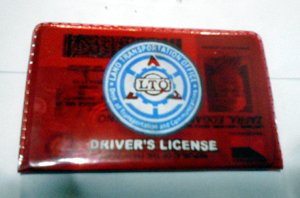Converting Student Permit To Driver’s License
 One fulfilling experience I had recently was to teach our only daughter-in-law how to drive their recently-acquired second-hand car and later go with her to an LTO (Land Transportation Office) branch to convert her Student Permit to Non-Professional Driver’s License. I am qualified to train our daughter-in-law how to drive because I hold a Professional Driver’s License which is an LTO requirement. In the Philippines, one is required to be 17-year old to be able to apply for a Student Permit before he starts learning how to drive.
One fulfilling experience I had recently was to teach our only daughter-in-law how to drive their recently-acquired second-hand car and later go with her to an LTO (Land Transportation Office) branch to convert her Student Permit to Non-Professional Driver’s License. I am qualified to train our daughter-in-law how to drive because I hold a Professional Driver’s License which is an LTO requirement. In the Philippines, one is required to be 17-year old to be able to apply for a Student Permit before he starts learning how to drive.
A Student Permit holder can opt to enroll with a Driving School but if a car is already owned or available for his/her driving lessons, learning how to drive under the guidance of a professional driver is another option. To many, the second option is better because the student driver will have more time to get the driving skills needed to pass the practical examinations required before a driver’s license is issued. The student driver has to pass the written examination before he could take the actual driving test.
After about twenty (20) hours of learning how to drive a sub-compact car with automatic transmission under my guidance and a few hours of review for the written examination, I feel confident that she is ready to convert her student permit to a non-professional driver’s license. She had to do this at least thirty (30) days after her student permit was issued as required by the LTO rules. Passing the drug test and medical examinations (blood pressure and vision tests) are also needed before one is issued a driver’s license.
One early morning last month, I accompanied her to the LTO-Calamba to undergo the examinations required to convert her Student Permit to Non-Professional Driver’s License. First stop was the drug test and medical examination which took her about 2 hours because there were many applicants for driver’s license (both new and renewal) that day, a Monday. If she failed the drug test, she’d have been taken to JC’s Recovery Center to conduct further tests and take possible action against her.
By 10:00 AM, her name was called to be among those who will take the written examination which she easily passed with a high score of 39 correct answers out of the 40 questions asked. I will write next about how to pass the LTO written examination because I learned that flunkers (those who failed to get 30 correct answers) usually outnumbered the passers.
After lunch, applicants who passed the written examination took the practical examination (actual driving test) at an area constructed specifically for the purpose of testing their driving skills and knowledge of traffic rules and regulations. The test field has white and yellow lanes, uphill and downhill slopes, sharp curves, railroad crossing, traffic light, pedestrian lane and yellow box to determine how the applicant reacts to various driving situations.
I noticed that almost 80% of the examinees were applying for licenses to drive motorcycles. Our daughter-in-law was the first one to take the examination and though a bit nervous, she passed the test using her own car. Those who do not have their own vehicle had to rent a car with manual transmission for PhP300.00 or a motorcycle for PhP150.00 to take the driving test.
By the way, our daughter-in-law successfully converted her student permit to non-professional driver’s license without using a “fixer” (paid facilitator). I also observed that there are no fixers in LTO-Calamba. What a welcome change from a bad practice in the past!




Interesting read! love the site you have going on here, looking forward to visiting often.